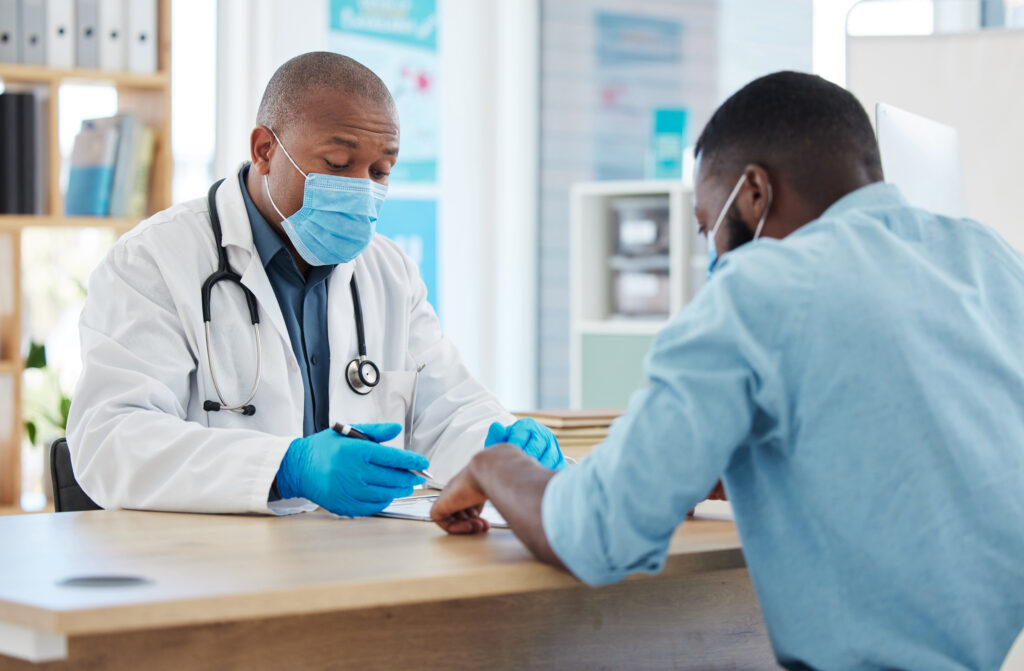
Prostate cancer is a cancer that develops in the prostate gland. This gland is only present in males, and functions to make a fluid that is a part of the semen. In their lifetime, about 1 in 8 men will be diagnosed with prostate cancer and about 1 in 43 men will die from it. In 2024, the American Cancer Society predicts about 299,010 new cases of prostate cancer and about 35,250 deaths from the disease.
The cancer often develops in older age. In younger men, the prostate gland is about the size of a walnut. But as the man ages, it grows bigger and becomes more susceptible to developing cancer. In rare cases, younger men can also get prostate cancer, especially in the presence of risk factors that increase their likelihood of developing this cancer.
Risk factors
Being over 50. Statistically, the risk of developing prostate cancer increases after the age of 50. About 60% of diagnoses are made to men who are over the age of 65. Age is the most common risk factor shared by the majority of individuals who get prostate cancer.
Being an African American male. While all men can get prostate cancer, the cancer develops more often and at a younger age in the men of African American descent and Caribbean men of African ancestry. In these individuals, the disease is often more advanced when it is first discovered and they are twice as likely to die from it.
Having the genetic risk factors. Not all genes that affect a person’s chance of getting prostate cancer are known. However, the disease is said to run in families. A person has an increased likelihood of developing prostate cancer if his father developed prostate cancer, and even more so if his brother developed prostate cancer.
Two known genetic conditions that can cause prostate cancer are:
- Being BRCA-positive. BRCA-positive individuals have a harmful mutation or mutations in their BRCA1 or BRCA2 gene. These mutations are often linked to breast cancer. But they also increase the likelihood of developing prostate cancer. From an estimation, about 10% of men diagnosed with metastatic prostate cancer (cancer that has spread from the prostate to other parts of the body) are BRCA-positive.
- Having Lynch syndrome. Lynch syndrome is an inherited combination of mutations that increases the likelihood of developing cancers such as colorectal and endometrial cancers. Lynch syndrome also increases the likelihood of developing prostate cancer.

Signs and Symptoms
Most men will not have any symptoms of prostate cancer. When present, the symptoms may include:
- Issues with urination. These include difficulty in starting urination and maintaining the flow of urine, difficulty in completely emptying the bladder, needing to urinate often, pain or a burning sensation during urination, and blood in the urine.
- Erectile dysfunction or painful ejaculation
- Losing weight without trying
- Pain in the bones, back, hips, or pelvis
These symptoms are not specific to prostate cancer and may be a result of other health conditions.
Early detection
If a cancer is discovered early, it can be easier to treat and control than a cancer that is discovered too late and has metastasized to other parts of the body. However, in the case of prostate cancer, medical experts weigh the benefits of early detection compared to the dangers of overtreatment.
This is because many forms of prostate cancer are extremely slow-growing, and the cancer is never expected to reach a stage where the person requires treatment or medical intervention. The patient will never have symptoms and can live out their lifetime oblivious to the slow-growing cancer. In such cases, learning that someone has cancer can prompt them and their medical providers to start treatment. Aggressive prostate cancer treatments such as chemotherapy may have more detrimental effects on a person’s quality of life than the cancer would have had.
Two studies that have been conducted did not show convincing evidence associating regular screening with a reduction in the overall death rate during the course of the studies. The decision to get regularly screened in older men is generally left to their own discretion and that of their healthcare providers.
In younger men with risk factors, screening may be beneficial as the cancer could shorten their lifespan. Currently, men between the ages of 40-80 who get diagnosed with prostate cancer have an average 5-year survival rate of 95-100%. While it is extremely rare for younger men aged 15-25 to develop prostate cancer, the cancer is much more aggressive if it develops. This age group’s 5-year survival rate is only around 30%, which indicates that regular screening may be beneficial for teens and young men if they have genetic risk factors.

Treatment
The following approaches are used to treat prostate cancer.
- Surgery. The prostate is surgically removed in a procedure called prostatectomy. Sometimes prostate is removed with seminal vesicles which are glands next to the prostate that produce some semen ingredients. If the cancer has not spread outside of the prostate, then surgery can offer an excellent long-term prognosis.
- Radiation therapy. High-energy rays or particles are used to kill cancer cells. In the early stages of cancer, it can have about 90% effectiveness at curing cancer. This treatment can be used in combination with other treatments such as hormone therapy to increase effectiveness. The treatment helps with new and recurrent cancer and can be palliative and reduce pain in advanced cancer.
- Hormone therapy. Androgens which include testosterone and dihydrotestosterone promote the growth of prostate cancer. Androgens are mostly generated by the testicles, though some can be generated by the adrenal glands and the prostate gland itself. Hormone therapy uses surgical and chemical methods to block androgen production. Surgically, it involves removing the testicles. Chemically, drugs are administered that reduce the testosterone produced by the testicles. These include luteinizing hormone-releasing hormone (LHRH) agonists which are injected or implanted under the skin. In more advanced stages, other drugs called LHRH antagonists are given as a monthly injection. Hormone therapy can shrink the cancer or slow its progression. It cannot cure the cancer and cancers can get resistant to hormone therapy over time.
- Chemotherapy. Medications are used to shrink or kill the cancer cells. Chemotherapy is unlikely to cure prostate cancer on its own, and it is not a standard therapy offered to prostate cancer patients. However, it might be offered if the cancer has spread significantly outside the prostate, or if it has become resistant to hormone therapy. It can also be used in combination with hormone therapy.
The information provided in our blog posts is for informational purposes only and is not intended as a substitute for professional medical advice, diagnosis, or treatment. Always seek the advice of your physician or other qualified health provider with any questions you may have regarding a medical condition. Never disregard professional medical advice or delay in seeking it because of something you have read on this blog.
 Do all ticks carry Lyme disease?
Prev post
Do all ticks carry Lyme disease?
Prev post





